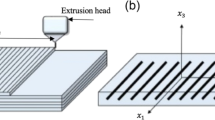Abstract
The currently used plaster cast for wrist orthotic treatment is relatively heavy, non-removable, and unventilated. Because of this, wearing this cast can generate problems including a variety of skin diseases, pilosis, and joint and ligament injuries. This case study describes a hybrid manufacturing methodology that utilizes three-dimensional printing (3D printing) and injection molding technology to create a wrist orthosis that solves the problems of the plaster casts. Compared with the previously presented wrist orthosis using 3D printing and three-dimensional scanning (3D scanning) technology, the proposed hybrid model significantly reduces the manufacturing time and cost. The core concept of the hybrid model is to separate the plastic cast into two parts: an inner structure produced by 3D printing that surrounds the skin and an outer cover that is fastened to the inner structure that protects the injured part from external forces. The outer cover is produced in advance using an injection molding method with three sizes based on the sizes of the wrist. From the result of wearing the prototype, it was confirmed that the new wrist orthosis has proper strength, good ventilation, and light weight. The time cost for manufacturing also was estimated as 1/3 of that of other methods. We anticipate that the hybrid method for customized 3D printed plastic orthosis can become a balanced solution that can be applied in the current additive manufacturing field in terms of manufacturing time and cost.
Similar content being viewed by others
References
M. T. Fitch, B. A. Nicks, M. Pariyadath., H. D. McGinnis and D. E. Manthey, Basic Splinting Techniques, The New England Journal of Medicine, 359 (26) (2008) e32.
Apollo Universal Wrist Brace, http://www.breg.com.
EXOS Bracing System, http://www.djoglobal.com.
L.C. Hieu, N. Zlatov, J. V. Sloten, E. Bohez, L. Khanh, P. H. Binh, P. Oris and Y. Toshev, Medical rapid prototyping applications and methods, Assembly Automation, 25 (4) (2005) 284–292.
C. Mavroidis, R. G. Ranky, M. L. Sivak, B. L. Patritti, J. DiPisa, A. Caddle, K. Gilhooly, L. Govoni, S. Sivak, M. Lancia, R. Drillio and P. Bonato, Patient specific ankle-foot orthoses using rapid prototyping, Journal of Neuro Engineering and Rehabilitation, 8 (1) (2011).
P. Webb, A review of rapid prototyping (RP) techniques in the medical and biomedical sector, Journal of Medical Engineering & Technology, 24 (4) (2000) 149–153.
D. Cook, V. Gervasi, R. Rizza, S. Kamara and XC. Liu, Additive fabrication of custom pedorthoses for clubfoot correction, Rapid Prototyping Journal, 16 (3) (2010) 189–193.
CORTEX, http://www.evilldesign.com/cortex.
OSTEOID, http://www.osteoid.com/.
Korean Agency for Technology and Standards, 6th Report of Size Korea 3D-scan Measurement project, http://sizekorea. kats.go.kr/.
S. W. Jeong, Conditions of rib design for polycarbonate resin with high glossy surfaces, Journal of Mechanical Science and Technology, 27 (10) (2013) 3023–3028.
R. A. Malloy, Plastic part design for injection molding, Second Ed., Hanser Gardner Publications, Cincinnati (2000).
D. Palousek, J. Rosicky, D. Koutny, P. Stoklásek and T. Navrat, Pilot study of the wrist orthosis design process, Rapid Prototyping Journal, 20 (1) (2014) 27–32.
A. M. J. Paterson, R. J. Bibb and R. I. Campbell, A review of existing anatomical data capture methods to support the mass customisation of wrist splints, Virtual and Physical Prototyping, 5 (4) (2010) 201–207.
Author information
Authors and Affiliations
Corresponding author
Additional information
Recommended by Guest Editor Sangho Park
Huhn Kim is a professor in the department of Mechanical System Design Engineering in Seoul National University of Science and Technology, Korea. He is a board of directors of UXPA Korea and life member of Ergonomics Society of Korea (ESK), Korean Society for Emotion & Sensibility (KSES). His research areas are human-computer interaction, user experience design, and ergonomic design.
SeongWon Jeong is a professor in the department of Product Design and Manufacturing Engineering in Seoul National University of Science and Technology, Korea. He is a regular member of Korean Society of Design Science (KSDS), Korean Society for Emotion & Sensibility (KSES). Research interests include product design, engineering design, design method, and Robot design. Product surface and tactile emotion are a recent focus of his studies.
Rights and permissions
About this article
Cite this article
Kim, H., Jeong, S. Case study: Hybrid model for the customized wrist orthosis using 3D printing. J Mech Sci Technol 29, 5151–5156 (2015). https://doi.org/10.1007/s12206-015-1115-9
Received:
Revised:
Accepted:
Published:
Issue Date:
DOI: https://doi.org/10.1007/s12206-015-1115-9




